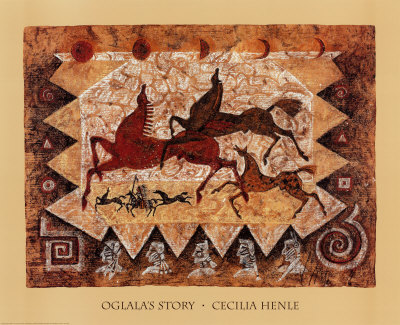Since the Indian hunting horse had different duties than that of a war horse, a different set of symbols were used to aid the hunting horse and his rider. Designed to help the Indian hunter in finding the buffalo herd, many of these symbols also brought favor from the Great Spirit.
The Indian hunter’s wife had the privilege of painting his hunting horse, and if he was unmarried, that privilege was his mother’s.
The Indian hunting horse obtained his speed and the stamina necessary for buffalo hunting from his Spanish and Barb breeding.
The Indian hunting horse could gallop alongside an unpredictable buffalo until his rider had shot an arrow into the beast’s side and dodge the angry animal in an instant if it chose to charge the horse and rider.
The inborn courage from this Spanish breeding aided these horses with courage to “cut” the dying buffalo from the herd to prevent his being trampled by the others. An Indian hunter prized a good buffalo horse as it meant sudden death if his horse panicked in fright.
The Indian hunter’s wife had the privilege of painting his hunting horse, and if he was unmarried, that privilege was his mother’s. The woman would take her honor seriously and would meditate on the meaning of each symbol before she would draw it on the hunting horse.
These are just some of the symbols an Indian woman would use:
![]() Sun of Happiness, a most important symbol, was used to insure blue skies. Indians never hunted during a rainstorm because they considered it unfair to the Great Spirit and to the buffalo.
Sun of Happiness, a most important symbol, was used to insure blue skies. Indians never hunted during a rainstorm because they considered it unfair to the Great Spirit and to the buffalo.
![]() Circle of Vision was the symbol painted around the horse’s eye to give keen sight and let him be the first to see the distant buffalo.
Circle of Vision was the symbol painted around the horse’s eye to give keen sight and let him be the first to see the distant buffalo.
![]() A Fence symbol was placed on the horse’s jaw to help keep in the good luck.
A Fence symbol was placed on the horse’s jaw to help keep in the good luck.
![]() The Sacred Buffalo symbol was to show the Great Spirit that the hunter was thankful for his past kills.
The Sacred Buffalo symbol was to show the Great Spirit that the hunter was thankful for his past kills.
![]() An Arrow of Swiftness was painted on the horse’s legs to give him speed.
An Arrow of Swiftness was painted on the horse’s legs to give him speed.
![]() Buffalo Tracks were painted over the horse’s hips symbolizing other good hunting times.
Buffalo Tracks were painted over the horse’s hips symbolizing other good hunting times.
![]() An After placing her hunter’s symbols on the hunting horse, the woman would draw a “secret” prayer on the horse’s hindquarters. This prayer was never explained prior to the hunt, and if her hunter came home successful, she proudly would tell the meaning of her symbols.
An After placing her hunter’s symbols on the hunting horse, the woman would draw a “secret” prayer on the horse’s hindquarters. This prayer was never explained prior to the hunt, and if her hunter came home successful, she proudly would tell the meaning of her symbols.
She would probably use this “lucky” prayer again and again.
Should her hunter return unsuccessful, she would be humiliated because the prayer she had painted was the wrong one. Then the other women of the tribe gossiped about her and would say that she was of little help to her provider,which would add to her embarrassment.
The hunter would sometimes spank her for drawing a bad-luck prayer, but sometimes he would feel sorry for her and share in the disgrace. If the woman’s hunter did the latter, he might explain that the prayer would bring double the luck to him on the next hunt.
Though tribal tradition dictated how and why an Indian painted his horse, the color preference of the horse was left to the individual. Generally, a bay horse was thought by the Sioux Indian as too common, with more preference given to sorrels and roans. The roans they called “scorched.”
Most favored were pintos, not only for their colorfulness, but for the advantage of natural camoflauge. When an Indian didn’t have one, he might paint his white or grey horse to resemble a pinto.
The special name of “freckled rump” was given to another favored mount of the Indian, the
Appaloosa, which is thought to have originated with the Nez Perce Indians.
Though the Indian no longer rides against enemies or chases the great buffalo, this unique way in which he expressed himself with symbols on his dearest possession, his horse, has often been captured on many contemporary art objects and displayed in modern day parades.

Oglalas Story
Buy This Art Print At AllPosters.com
Find out how you can use this image for FREE.
RELATED STORIES: